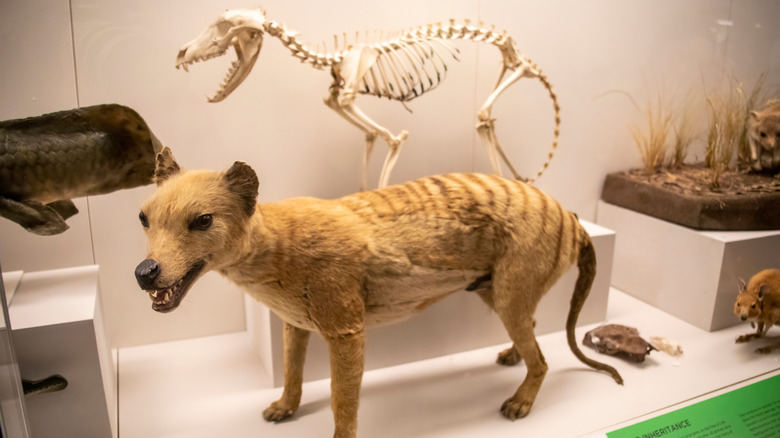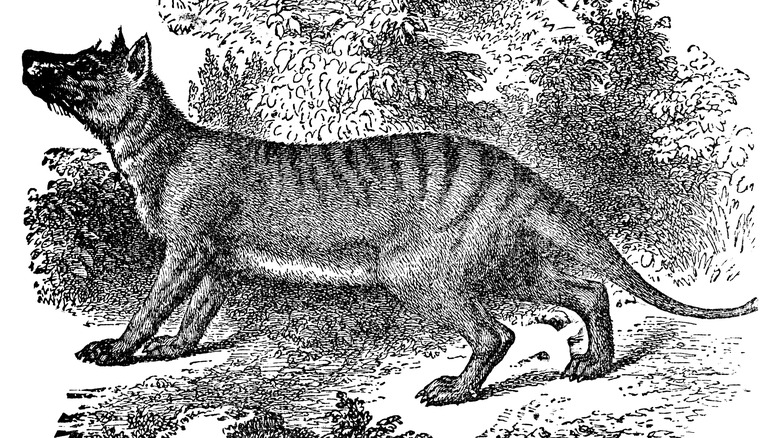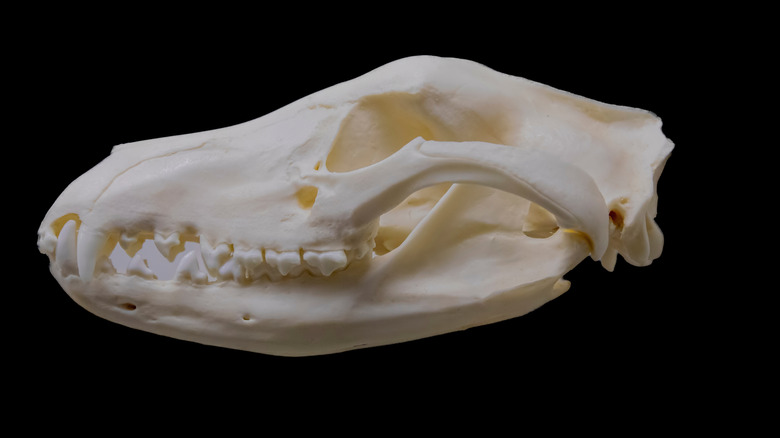What If The Tasmanian Tiger Never Went Extinct?
Tasmania's most famous native animal is undoubtedly the "devil" that bears its name, but if it weren't for a boost in notoriety thanks to Looney Tunes, a different resident of the island might have gained even more renown: the Tasmanian tiger. Technically known as a thylacine (Thylacinus cynocephalus), the animal's colloquial name references the stripes along its back, although it has little else in common with tigers. Thylacines are not felines, but rather members of the marsupial infraclass, which comprises mammals that have pouches.
Thylacines were once found throughout Australia, but they became isolated to Tasmania thousands of years ago due to competition from dingoes and early human residents. On Tasmania, they thrived, until they found themselves in the crosshairs of farmers, who were incensed over thylacines eating their livestock. They were labeled as pests, and the local government offered rewards for killing thylacines. In a particularly tragic turn, the government recognized their error and granted thylacines protected status in 1936, only for the final member of the species to die in captivity later that same year.
There is currently a bold project to revive the Tasmanian tiger using DNA gathered from preserved specimens, but reintroducing a species to an environment that hasn't seen it in nearly a century would have a major impact on the ecosystem. To understand the potential effects of Tasmanian tiger revival, it's important to ask what the world would look like today had they never gone extinct in the first place.
Tasmanian tigers could restore balance to the ecosystem
In their time, thylacines occupied the top position in the Tasmanian food chain, and removing an apex predator from its ecosystem has serious consequences. Without predators, other species within an ecosystem no longer face the issue of survival of the fittest, allowing for unchecked population growth. The Tasmanian tiger's extinction has allowed herbivores on the island to propagate beyond what their resources can support. Two of Australia's most iconic species, kangaroos and wallabies, have been at the center of this problem.
There are roughly 50 million kangaroos in Australia, more than twice the nation's human population. The species' numbers have grown unchecked of late, mainly due to the loss of their natural predators: dingoes on the mainland and thylacines on Tasmania. As the kangaroo population rises, competition for food grows ever more intense. Kangaroos are increasingly turning to cropland for food, inciting local farmers and prompting large-scale culling of the animals in certain areas.
If thylacines had remained alive and well in Tasmania for all these years, kangaroo populations could not have reached such unsustainable levels. A similar situation played out in Yellowstone National Park at the end of the 20th century, where the loss of local wolves allowed elk populations to grow unchecked which decimated vegetation. When wolves were reintroduced, the overpopulation crisis was solved, but these issues would never have arisen in the first place if predators like wolves and thylacines hadn't been wiped out from their home ranges.
Tasmanian tigers might go extinct anyway
If Tasmanian tigers had not gone extinct in 1936, they would still not be free from the risk. In fact, it's quite likely that thylacines would be facing the threat of extinction today whether humans hunted them or not. That's because thylacines had a major problem when it came to genetics. Being confined to a small island is not conducive to diversity, inevitably leading to inbreeding and a more limited gene pool.
Genetic diversity is essential for a species' ability to adapt to challenges in their environment, especially disease. If all the members of a population have identical genetics, they will all be vulnerable to the same conditions. The devastating impact of this can be seen right now in a former neighbor of the thylacine: the Tasmanian devil. Tasmanian devils face the same problem of having a limited gene pool on a small island. Over the past four decades, an aggressive form of contagious cancer has been spreading amongst Tasmanian devils, killing as much as 80% of the population. This has prompted their inclusion on the endangered species list.
Such a disease would be even more dangerous for thylacines. In a study published in the journal PLOS One, researchers sequenced the genomes of thylacines preserved in museums and found that all of the animals had 99.5% identical genes. That's even more homogeneity than the Tasmanian devil population. If Tasmanian tigers had survived to this day, they could be one outbreak away from elimination.


